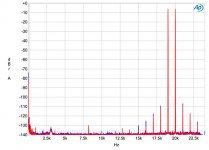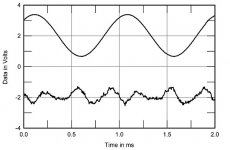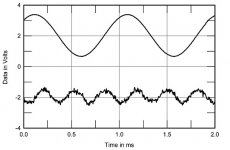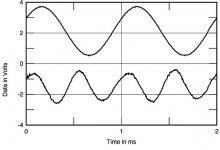Best to voice drivers in at 1 watt input no xover , there naturnal positives and negatives will show here...
I am not following you here. 90% of what I would call vlocing a speaker and is tweaking the crossover in a multi-driver system where you have not just environment issues, but direct driver interference. (Unless of course, you are in the Louther camp) I do start at one watt. Or are you talking about room tuning and don't want the extra variables of multi-driver interference confusing the results? I have not had any luck going outside as I voice my speakers for the exact room where I am using them. A luxury OEM's do not have. Advantage DIY.
Voice drivers, Voice speakers , 2 different procedures.....
Yes i can see that with your drivers, i would run the volume as loud as necessary for you to get an sonic signature from the driver, Ideally the xover should be minimal enuff to keep the sonic character of the driver , but not too minimal. Drivers with sibilance issues, coloration, noisy frames, etc, will be obvious to you ...
I usually like to hold the drivers or get as close as possible for tweeters, mid units and even for bass units...
I usually like to hold the drivers or get as close as possible for tweeters, mid units and even for bass units...
Last edited:
Loud enough to excite things in the room, like china cabinet backs and nick-knacks not on soft feet! It could be my environment, but much softer and the background makes it hard to pick out problems. In my office where I do the basic setup, I use 1V RMS as a standard so I can compare things later. 1W would be way too loud as you say. 1V is enough to send my wife to the other end of the house and sometimes I wear ear protectors. It must work. I was playing around with a tweeter today and found I can still hear 18K. That surprised me due to my age.
a.wayne, I guess I don't follow you on voicing drivers. Are you talking about modifications to the actual driver as would be done by the driver designer? That is out of my league. I just sent my paycheck to Seas, Scan-Speak or SB. Playing with the SB tweeter. Better than it is given credit for.
a.wayne, I guess I don't follow you on voicing drivers. Are you talking about modifications to the actual driver as would be done by the driver designer? That is out of my league. I just sent my paycheck to Seas, Scan-Speak or SB. Playing with the SB tweeter. Better than it is given credit for.
Yes i can see that with your drivers, i would run the volume as loud as necessary for you to get an sonic signature from the driver, Ideally the xover should be minimal enuff to keep the sonic character of the driver , but not too minimal. Drivers with sibilance issues, coloration, noisy frames, etc, will be obvious to you ...
I usually like to hold the drivers or get as close as possible for tweeters, mid units and even for bass units...
If you play with metal drivers, you will find "minimal" is a disaster. I don't have enough experience to correlate what I hear in a tweeter by itself to what I will get out of it in a system, unless it is defective or just plain garbage.
I'm a fan of SEAS, Morel best value for tweeter. A good starter would be SEAS drivers and tweeters. It's been awhile i have not heard any of this new stuff to give any advice.
I build my own ribbon drivers now whenever i want to fool around and use SEAS woofers ...
I have been playing with the 27TB metal dome series, but am leaning back to the cheaper little SB or the HDS. Someday I'll spring for a big Scan Speak. I have built several systems using "new" cone type mid/bass like metal or carbon. I am leaning back to paper. I guess I just don't like metal. I like the Peerless and Usher. There is a Seas "reed" paper that looks promising. Bamboo is turning up, but so far on poor motors so I can't comment.
You'll have to tell me about the ribbons someday. I built one out of Speaker Builder years ago. It sounded like what it was, foil between two screws. The ribbons I have heard never impressed me. They have it in theory in spades. I went as far as building a speaker with no moving parts. Crone effect. It did make noise, and enough ozone to kill the Western world. Copier HV supply, wire-wrap mother board pins for the probes and a copper screen for the grid. I went back to buying my drivers.
SOUND QUALITY VS MEASUREMENT
It does appear that Soulution Amplifiers have the measurement crown, Sound..?
The following sentence appeared in a review of the Soulution 710 published in October 2005 in the German magazine Stereo: "Lab chief technician Rolf Hähle has hung the test certificate for the Soulution 710 in a golden frame over his measuring desk." I wouldn't go quite that far, but the Soulution 710 is definitely one of the best-measuring amplifiers I have encountered. Color me impressed.—John Atkinson
Soulution 710 power amplifier Measurements | Stereophile.com
This amplifier channel's proprietary 12MHz-bandwidth zero-feedback voltage amplifier is sealed and potted to avoid prying eyes. 14 bipolar Sanken output transistors couple to a thick temperature-controlled copper bar. Schürmann explained how his circuit does not rely on common transistor matching to operate perfectly within tightly regulated performance specs.
6moons industry features: A visit to Soulution
What are they doing differently from Chris Hansen , who's zero NFB AYRE amplifiers do not measure near as well ..?
It does appear that Soulution Amplifiers have the measurement crown, Sound..?
The following sentence appeared in a review of the Soulution 710 published in October 2005 in the German magazine Stereo: "Lab chief technician Rolf Hähle has hung the test certificate for the Soulution 710 in a golden frame over his measuring desk." I wouldn't go quite that far, but the Soulution 710 is definitely one of the best-measuring amplifiers I have encountered. Color me impressed.—John Atkinson
Soulution 710 power amplifier Measurements | Stereophile.com
This amplifier channel's proprietary 12MHz-bandwidth zero-feedback voltage amplifier is sealed and potted to avoid prying eyes. 14 bipolar Sanken output transistors couple to a thick temperature-controlled copper bar. Schürmann explained how his circuit does not rely on common transistor matching to operate perfectly within tightly regulated performance specs.
6moons industry features: A visit to Soulution
What are they doing differently from Chris Hansen , who's zero NFB AYRE amplifiers do not measure near as well ..?
Attachments
Interesting comments on the "sound" of the amp, too.
Yes ...
The amp on the picture shows significant phase intermodulation: different heights of sideband strips.
Glad you mentioned that , then why the rave? very low distortion .....
Yes, low level of harmonics generated by intermodulation, but 5 microseconds of phase intermodulation is already audible as something artificial. Especially on stereo, when it means already uncertain stereo image localization. It sounds like paradox, but much easier measurable effects caused by Doppler effect in speakers is less audible! My understanding is, because human perception got used to mechanical alterations during long time of evolution, while electrical errors are something new in the recent life of each individual.
On my learning front that was initiated by the question of this thread, I have three questions for today:
Conventional input stage. LTP etc. The major value of feeding the legs with a current mirror is that when using only one output, it is hard to predict/manage the impedance of the second stage. Forcing balance with less than perfect diff transistor is secondary. The current mirror forces balance in the diff pair regardless. Am I starting to get that correct? Second, I have not seen the Wilson current mirror in any of the schematics I have. Is it past the diminishing returns point? Thirdly, if I power the input stage from a regulated supply, is there as much advantage to have a CCS in the tail? I can read the books, but they don't answer questions yet. It seems to me I have seen comments something like "the CCS measures great, but does not sound the best" which does not make complete sense but I am sure there are a hundred smaller factors of which I know not.
If I put all of these questions together, it leaves a fourth bonus question: If one uses a matched pair i.e single die, for the current mirror, is the diff pair as critical? This would leave open the possibilities for JFETS not available as monolithic pairs.
Conventional input stage. LTP etc. The major value of feeding the legs with a current mirror is that when using only one output, it is hard to predict/manage the impedance of the second stage. Forcing balance with less than perfect diff transistor is secondary. The current mirror forces balance in the diff pair regardless. Am I starting to get that correct? Second, I have not seen the Wilson current mirror in any of the schematics I have. Is it past the diminishing returns point? Thirdly, if I power the input stage from a regulated supply, is there as much advantage to have a CCS in the tail? I can read the books, but they don't answer questions yet. It seems to me I have seen comments something like "the CCS measures great, but does not sound the best" which does not make complete sense but I am sure there are a hundred smaller factors of which I know not.
If I put all of these questions together, it leaves a fourth bonus question: If one uses a matched pair i.e single die, for the current mirror, is the diff pair as critical? This would leave open the possibilities for JFETS not available as monolithic pairs.
This is where subjectivists and objectivists meet. I understand Fremer does his listening evaluation before Atkinson does his measurements, so thumbs up for his ears.
If anything, it also shows that further reduction of measurable deviations from perfect, may still pay out in acoustical terms.
The interesting thing though is that other amps that measure badly can still sound great. I don't know how to link to that article in Stereophile about the WAVAC, but it doesn't do well on the test bench, that is one thing I remember. However, the listening tests were very positive, and there sonic quality is substantiated by other samplers. I remember a recent post by John Curl mentioning WAVAC as one of the highlights of the show.
So, there are two possibilities here. Either the WAVAC is a perfect effects box. Or, amps like the WAVAC and the Soulution do something else right, something which still evades measurement, but which is essential in producing the most natural sound without audible artifacts.
vac
If anything, it also shows that further reduction of measurable deviations from perfect, may still pay out in acoustical terms.
The interesting thing though is that other amps that measure badly can still sound great. I don't know how to link to that article in Stereophile about the WAVAC, but it doesn't do well on the test bench, that is one thing I remember. However, the listening tests were very positive, and there sonic quality is substantiated by other samplers. I remember a recent post by John Curl mentioning WAVAC as one of the highlights of the show.
So, there are two possibilities here. Either the WAVAC is a perfect effects box. Or, amps like the WAVAC and the Soulution do something else right, something which still evades measurement, but which is essential in producing the most natural sound without audible artifacts.
vac
Last edited:
Wave,
What are we really looking for here as depicted in the below screen shots, what is good better , best !!!!

I would say the first picture is the best because it show the largest randomness, i.e. noise, versus a repetitive distortion residue. Secondly, the repetitive part seems to be mainly 3rd order distortion if I counted right, not that much of a problem. Interesting is that the repetitive part of the residue is neatly phase aligned with the fundamental. Could that be a clue to something?
vac
If anything, it also shows that further reduction of measurable deviations from perfect, may still pay out in acoustical terms.
Of course it does!
For example, line array of small speakers from floor to ceiling sounds much more natural than traditional speakers with single drivers. For the same sound pressure drivers in line arrays do much shorted excursion, that greatly reduces distortions generated by them. And so on. The point is, efforts have to be applied where they lead to audible results, instead of lowering down THD of power amp from 0.01 to 0.001% where such reduction is inaudible, but means to reduce THD cause another audible artifacts.
I would say the first picture is the best because it show the largest randomness, i.e. noise, versus a repetitive distortion residue. Secondly, the repetitive part seems to be mainly 3rd order distortion if I counted right, not that much of a problem. Interesting is that the repetitive part of the residue is neatly phase aligned with the fundamental. Could that be a clue to something?
vac
With the third one being the worst ...? OK so better to have the random noise than for it to follow the signal as in pic 3 ...?
"So, there are two possibilities here. Either the WAVAC is a perfect effects box. Or, amps like the WAVAC and the Soulution do something else right, something which still evades measurement, but which is essential in producing the most natural sound without audible artifacts."
I vote for number two. That of course does not preclude amps that measure very well from also sounding very pleasing.
I vote for number two. That of course does not preclude amps that measure very well from also sounding very pleasing.
- Status
- Not open for further replies.
- Home
- Member Areas
- The Lounge
- Sound Quality Vs. Measurements



